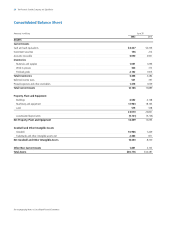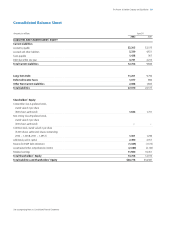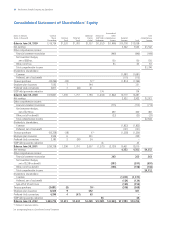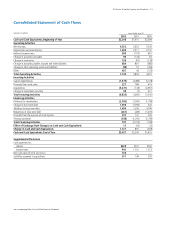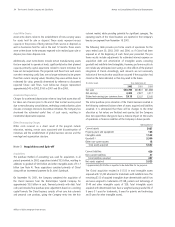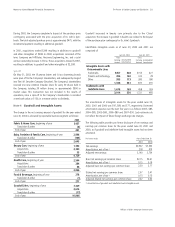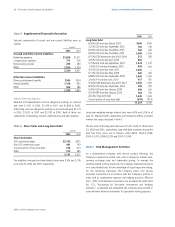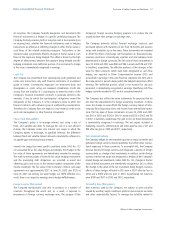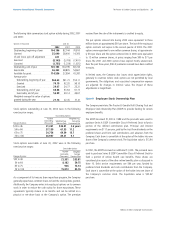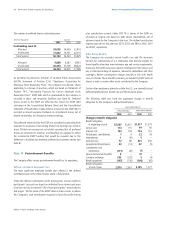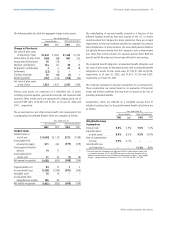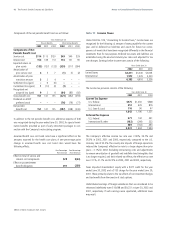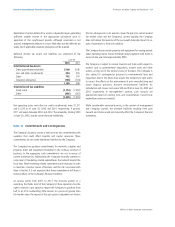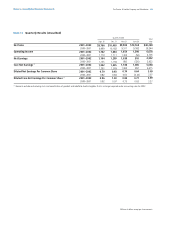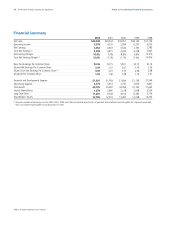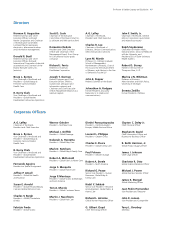Proctor and Gamble 2002 Annual Report Download - page 39
Download and view the complete annual report
Please find page 39 of the 2002 Proctor and Gamble annual report below. You can navigate through the pages in the report by either clicking on the pages listed below, or by using the keyword search tool below to find specific information within the annual report.37The Procter & Gamble Company and Subsidiaries
At inception, the Company formally designates and documents the
financial instrument as a hedge of a specific underlying exposure. The
Company formally assesses, both at inception and at least quarterly on
an ongoing basis, whether the financial instruments used in hedging
transactions are effective at offsetting changes in either the fair value or
cash flows of the related underlying exposure. Fluctuations in the
derivative value are generally offset by changes in the fair value or cash
flows of the exposures being hedged. This offset is driven by the high
degree of effectiveness between the exposure being hedged and the
hedging instrument. Any ineffective portion of an instrument’s change
in fair value is immediately recognized in earnings.
Credit Risk
The Company has established strict counterparty credit guidelines and
enters into transactions only with financial institutions of investment
grade or better. Counterparty exposures are monitored daily and
downgrades in credit rating are reviewed immediately. Credit risk
arising from the inability of a counterparty to meet the terms of the
Company’s financial instrument contracts is generally limited to the
amounts, if any, by which the counterparty’s obligations exceed the
obligations of the Company. It is the Company’s policy to enter into
financial contracts with a diverse group of creditworthy counterparties.
Therefore, the Company does not expect to incur material credit losses
on its risk management or other financial instruments.
Interest Rate Management
The Company’s policy is to manage interest cost using a mix of
fixed- and variable-rate debt. To manage this risk in a cost efficient
manner, the Company enters into interest rate swaps in which the
Company agrees to exchange, at specified intervals, the difference
between fixed and variable interest amounts calculated by reference to
an agreed-upon notional principal amount.
Interest rate swaps that meet specific conditions under SFAS No. 133
are accounted for as fair value hedges. Accordingly, the changes in the
fair value of these agreements are immediately recorded in earnings.
The mark-to-market values of both the fair value hedging instruments
and the underlying debt obligations are recorded as equal and
offsetting gains and losses in the interest expense component of the
income statement. The fair value of the Company’s interest rate swap
agreements was approximately $231 at June 30, 2002 and $125 at
June 30, 2001. All existing fair value hedges are 100% effective. As a
result, there is no impact to earnings due to hedge ineffectiveness.
Foreign Currency Management
The Company manufactures and sells its products in a number of
countries throughout the world and, as a result, is exposed to
movements in foreign currency exchange rates. The purpose of the
Company‘s foreign currency hedging program is to reduce the risk
caused by short-term changes in exchange rates.
The Company primarily utilizes forward exchange contracts and
purchased options with maturities of less than 18 months and currency
swaps with maturities up to five years. These instruments are intended
to offset the effect of exchange rate fluctuations on forecasted sales,
inventory purchases, intercompany royalties and intercompany loans
denominated in foreign currencies. The fair value of these instruments at
June 30, 2002 and 2001 were $60 and $94 in assets and $29 and $101
in liabilities, respectively. The effective portions of the changes in fair
value for these contracts, which have been designated as cash flow
hedges, are reported in Other Comprehensive Income (OCI) and
reclassified in earnings in the same financial statement line item and in
the same period or periods during which the hedged transactions affect
earnings. The ineffective portion, which is not material for any year
presented, is immediately recognized in earnings. Qualifying cash flow
hedges currently recorded in OCI are not considered material.
The Company also utilizes the same instruments for purposes that do
not meet the requirements for hedge accounting treatment. In these
cases, the change in value offsets the foreign currency impact of inter-
company financing transactions and income from international opera-
tions. The fair value of these instruments at June 30, 2002 and 2001
was $93 in 2002 and $126 in 2001 in assets and $25 in 2002 and $6
in 2001 in liabilities, respectively. The gain or loss on these instruments
is immediately recognized in earnings. The net impact included in
marketing, research, administrative and other expense was a $31 and
$24 after-tax gain in 2002 and 2001, respectively.
Net Investment Hedging
The Company hedges its net investment position in major currencies and
generates foreign currency interest payments that offset other transac-
tional exposures in these currencies. To accomplish this, the Company
borrows directly in foreign currency and designates a portion of foreign
currency debt as a hedge of net investments. In addition, certain foreign
currency interest rate swaps are designated as hedges of the Company’s
related foreign net investments. Under SFAS No. 133, changes in the fair
value of these instruments are immediately recognized in OCI, to offset
the change in the value of the net investment being hedged. Currency
effects of these hedges reflected in OCI were a $397 after-tax loss in
2002 and a $460 after-tax gain in 2001. Accumulated net balances
were $180 and $577 in 2002 and 2001, respectively.
Commodity Price Management
Raw materials used by the Company are subject to price volatility
caused by weather, supply conditions, political and economic variables
and other unpredictable factors. To manage the volatility related to
Notes to Consolidated Financial Statements
Millions of dollars except per share amounts



